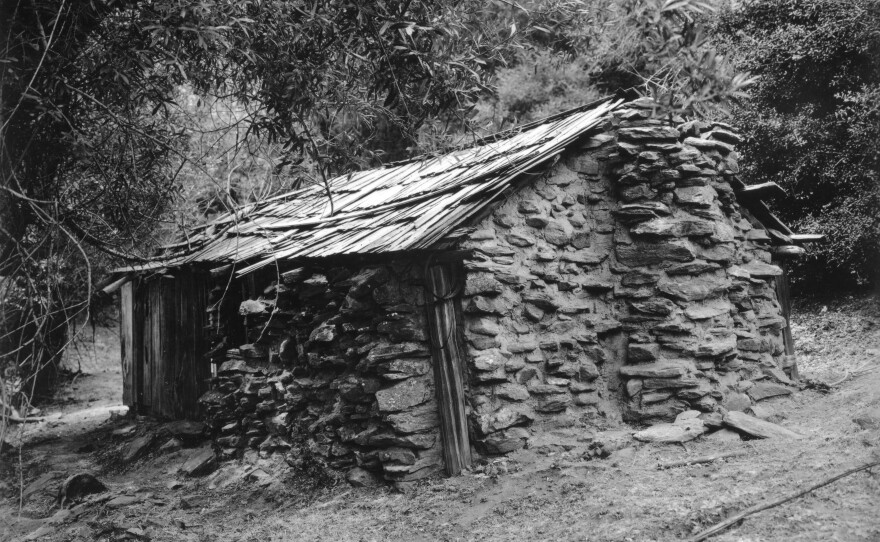San Diego History Center has opened a companion exhibit to its Celebrate San Diego: Black History and Heritage. The new exhibit focuses on San Diego's first Black homesteader Nathan Harrison who died in 1920. The exhibit, Nathan Harrison: Born Enslaved, Died A San Diego Legend, shows how archaeology played a role in fleshing out Harrison's life and is challenging ideas about local history.
Companion viewing
Since there are not really any films about early Black homesteaders, check out these documentary films and shows about archaeology.
"Animal, Vegetable, Mineral?" (TV show, 1952-1959)
"Time Team" (TV show, 1994-2014)
"Lost Kingdoms of Africa" (TV show, 2010)
"Nostalgia for the Light" (2010)
"Cave of Forgotten Dreams" (2010)
Seth Mallios is an archaeologist but on a certain level he’s just going through people’s garbage.
"It wouldn't be glamorous if I went through your garbage, but boy is it authentic," Mallios said. "Whenever somebody writes something down, they're aware of a future audience and so a lot of bias goes into that. But when you take out your garbage in the morning, you're not expecting that my students and I are going to quickly jump on it and do a lot of research. That’s where I feel this is some pretty authentic glimpses into Harrison’s life."
Seven years ago, Mallios started going through Nathan Harrison’s garbage from the mid-1800s to figure out who this San Diego legend might have been since there was little information about his life outside of a vast archive of photographs. Harrison was famous as San Diego’s first Black homesteader.

"He was one of San Diego's first tourist destinations," said Tina Zarpour, vice president of Community Engagement, Education, and Collections at San Diego History Center. "People would make a trek, a three-day journey, from San Diego to Palomar Mountain to come and see him and bring provisions and different gifts and things like that. I think he was probably good at telling a story and entertaining."
But Harrison had to overcome incredible hardship and obstacles before obtaining his freedom and becoming one of San Diego’s most photographed residents (more photographed than Wyatt Earp who lived here around the same time). Harrison was brought west from Kentucky as a slave and in the late 1800s, he made his permanent homestead on top of Palomar Mountain. That’s where Mallios found Harrison’s cabin along with 50,000 artifacts. But what Mallios discovered in June of 2004 didn’t look like a cabin.
"There wasn't a cabin standing there," Mallios said. "It was it was waist-high weeds, rattlesnakes, scorpions, you name it, right out of Indiana Jones."
This is where garbage becomes buried treasure. But you have to know where to look.
"Because I've dug a lot of African-American sites in different parts of the country, I'm used to the fact that the houses are usually pretty empty and the patio is where all the good stuff is," Mallios explained. "The patio itself is an Africanism. It's something that came over from West Africa. There weren't patios here before those first enslaved Africans were brought over. And so we were digging and we found the footings and there was nice stuff there. And there was some special stuff there, things like a pocket watch. There's a skeleton key right under the doormat where it's supposed to be. Then we started digging the patio and that's where it got really exciting because that's where you started seeing thousands of artifacts and this is where we have a moment where you leave the artifacts in place and you just remove the dirt. And it's pretty spectacular because you will see a thousand artifacts in one 5-foot square and it'll be everything — sheep bones. It'll be whiskey bottles. It'll be tobacco. It'll be a tobacco pipe. It'll be presidential suspenders. Harrison wore these very fancy Sears and Roebuck presidential suspenders and that's the fun of all those small things together that tell you about everyday life."
With each new unearthed item, Mallios was able to create a more vivid picture of Harrison, the man who had married different indigenous women at different times and was baptized Catholic by the chief of the Rincon tribe.
"We found a little iron cross, a little pendant that is highly personal and very specific to Nathan Harrison," Mallios said. "But it also tells this bigger story that Catholics were persecuted against during this time. So think about this for a second. He's African-American. He's married to an indigenous woman and he's a converted Catholic. All these things put him in the crosshairs and very dangerous situation. And so that's my response to why are you spending so much time on just one person and just one person's garbage? Because it's such a robust story."
A story that reveals how African Americans have had to navigate a world of inequities. For Harrison, it involved the kind of dual identities that we now refer to as code-switching.
"Nathan Harrison was the ultimate code switcher for sure," Zarpour said. "And those were very purposeful identities. There was sort of the public persona and then there was the private persona. [So] what can we learn about our community and our society now by examining the life of this one individual and the obstacles that he had to overcome, the ways that he had to kind of negotiate different things, negotiate power and identity, the different things that he had to bring together in his life in terms of survival."
When conceived in 2019, the exhibit was going to be a 100-year anniversary celebration of Harrison but after 2020, with the pandemic and the Black Lives Matter movement, the exhibit transformed into something deeper.
"A lot of the Nathan Harrison story is about all the challenges he faced in terms of structural inequity," Mallios said. "He was brought to California as a slave and what that meant was when California entered the Union as a free state, he stayed a slave to the white owners who weren't forced to give up their property, and that's what slaves were seen as. So he and thousands of others like him stayed a slave in this free state. California wasn't a free state for Nathan Harrison. And so this is the story of Harrison, who was continually facing these long odds and having to find a new community and a new way to just make do. Now we're opening in 2021 and now these issues ask that question, do ethnic minorities still face these sorts of struggles in terms of structural inequity? Do they need to put on an act to get by? Those are things that Harrison was dealing with over 100 hundred years ago and that's a key part of the story now."
Mallios hopes the exhibit helps people see California history differently.
"That they don't buy into this whitewashed version of the history of California being a free state, land of racial harmony, because that truth is not only is a myth, it's pretty offensive for all those disempowered peoples that were killed, enslaved, robbed and so forth," Mallios stated. "I don't know anybody that teaches San Diego history and talks about Jim Crow's role in San Diego. We think of Jim Crow as being a southern issue."
But the History Center is being secretive about one aspect of the exhibit.
"The the big punch line to this exhibit — and I'm not going to give it away because you have to come down here to see it — but it's how archaeology revealed a big secret about Harrison's identity. And that's something you have to go inside the cabin to figure out that story."
So your invitation to play Indiana Jones awaits you at San Diego History Center’s latest exhibit on Nathan Harrison: Born Enslaved, Died a San Diego Legend, where a replica of his cabin has been created for you to enter and explore. It is a way to experience someone else's life and see how it connects to what is going on today.
And here is a video about the History Center's companion Celebrate San Diego exhibit.






